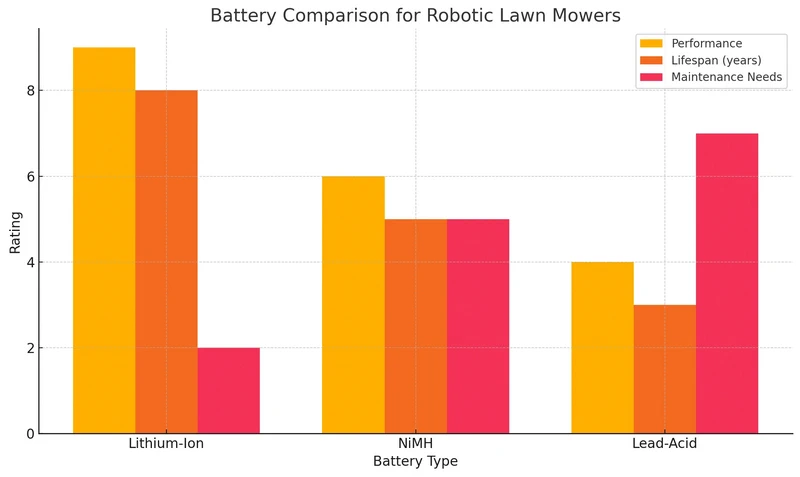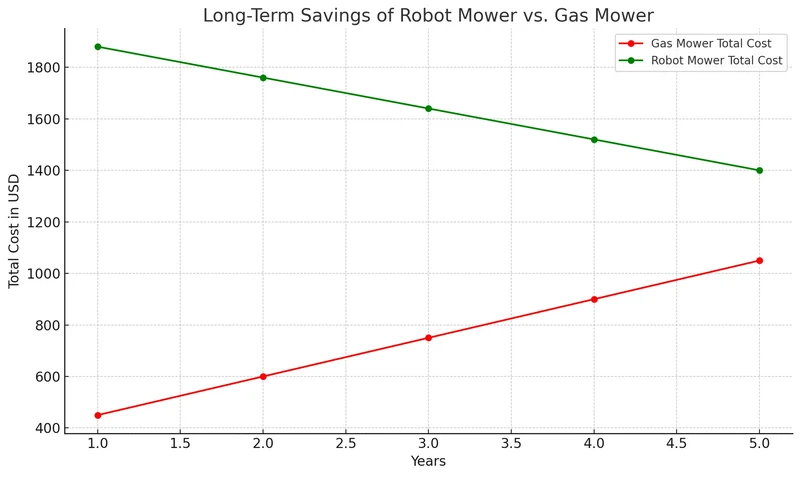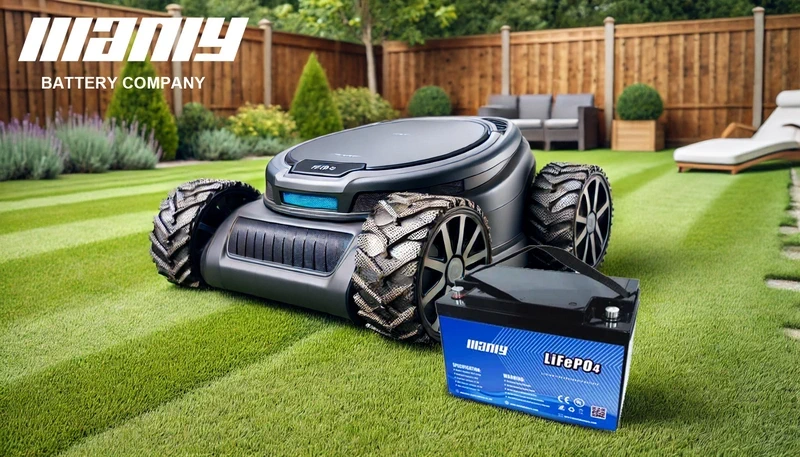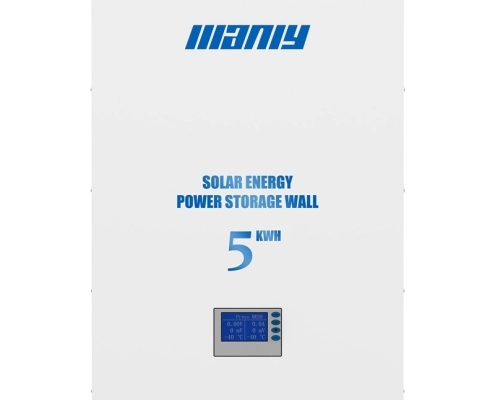Robot Lawn Mowers: Everything You Need to Know
Table of Contents
If you’re considering a robot lawn mower, you’re likely searching for a more innovative, more efficient way to maintain your yard. These cutting-edge machines offer a solution to the time-consuming task of traditional lawn mowing. Robotic lawn mowers are gaining popularity and are equipped with advanced features such as autonomous operation, quiet performance, and eco-friendly batteries. In this article, we’ll explore how these mowers work, their key features, and how robot lawn mower batteries play a crucial role in their performance. By the end, you’ll understand if a robotic mower is the right investment for your lawn care needs.
Understanding Robotic Lawn Mowers
If you’re tired of spending hours mowing your lawn and want a more innovative, more efficient way to keep it neat, a robotic lawn mower might be the solution you’re looking for. These autonomous devices revolutionize lawn care, offering convenience, quiet operation, and environmentally friendly features. This section will explain how robotic lawn mowers work and highlight the key features that make them valuable to any yard.
1. How These Mowers Work
At the heart of a robot lawn mower is its ability to operate autonomously, with little to no intervention from the user. The first step in using a robotic mower is setting up its working area. Many models require a boundary wire, a thin cable that defines the yard’s perimeter. The mower uses this wire to guide and ensure it stays within the designated area, avoiding obstacles like gardens, sidewalks, or neighbor’s lawns.
However, newer models are leaping forward using GPS navigation or onboard cameras to eliminate the need for boundary wires. These high-tech mowers can navigate your lawn by mapping out the area and making real-time decisions based on your yard’s layout and features. Using sensors, the mower detects obstacles like trees, flower beds, or pets and adjusts its route accordingly, ensuring it does not collide with anything in its path.
Robotic mowers can also automatically return to their charging station when their battery is running low. Once recharged, they pick up right where they left off, ensuring consistent and efficient mowing. This level of automation makes them incredibly convenient for homeowners who want to keep their lawns in shape without lifting a finger.
2. Key Features of Modern Mowers
Robotic lawn mowers are designed with a range of advanced features that make lawn care easier, more efficient, and eco-friendly.
- Automatic Mowing: Modern robotic mowers can be scheduled to operate at specific times, meaning your lawn gets trimmed regularly without you having to consider it. Some models also have sensors that detect rain, automatically pausing the mowing process when the weather gets too wet and resuming when conditions improve.
- Quiet Operation: Unlike traditional gas-powered mowers, which can be loud and disruptive, robotic lawn mowers are designed to operate quietly. Most models generate noise levels of about 60 to 70 decibels, similar to a normal conversation. This makes them ideal for residential areas where you don’t want to disturb your neighbors.
- Eco-Friendly and Energy-Efficient: Robotic mowers are typically powered by rechargeable lithium-ion batteries, which are much more energy-efficient and environmentally friendly than gas-powered alternatives. These mowers produce zero emissions, which makes them a great choice for environmentally conscious homeowners.
- Intelligent Scheduling and App Integration: Many robotic mowers have app connectivity, allowing you to control and schedule mowing times from your smartphone. Some even integrate with smart home systems, enabling you to control the mower through voice commands via a smart speaker.
- Grass Mulching: One of the standout features of robotic mowers is their ability to mulch the grass as they cut. Instead of collecting grass clippings, these mowers cut the grass into tiny pieces and leave it on the lawn. This mulching process returns vital nutrients to the soil, which helps promote a healthier and greener lawn over time.
- Safety Features: Safety is a priority with robotic mowers. These machines are designed with sensors that detect when they’re lifted or tilted, automatically shutting off the blades to prevent injury. Many models also include a PIN code or a GPS tracker to prevent theft, adding an extra layer of security.
Insights into the Battery System
The battery is the driving force behind robotic lawn mowers’ autonomous operation. It determines how long the mower can run on a single charge and impacts its long-term performance. Understanding how the battery works, why certain types are favored, and how to care for it will help ensure your mower operates smoothly for years. In this section, we will explore the different types of batteries used in robotic mowers, explain why lithium-ion batteries are typically the best choice, and provide helpful tips on when and how to replace your battery.
1. Types of Batteries Used in Robotic Mowers
Robotic lawn mowers depend on several different types of batteries, each offering specific benefits and drawbacks. The most common options are lithium-ion, nickel-metal hydride (NiMH), and lead-acid batteries.
- Lithium-ion batteries are generally the preferred option due to their high energy density. This means they can store significant power in a compact form, allowing the mower to run for extended periods before recharging. Lithium-ion batteries also last longer than other types, providing excellent value. They are lightweight, efficient, and maintain performance across various temperatures, making them ideal for outdoor devices like robotic mowers.
- Nickel-metal hydride (NiMH) batteries are another common choice, although they are being phased out in favor of lithium-ion. NiMH batteries are heavier, have lower energy density, and generally offer a shorter lifespan. While they are less expensive, their need for frequent charging and lower overall efficiency make them less desirable.
- Lead-acid batteries are the least common in modern robotic mowers. Although the least expensive, they tend to be bulkier and less durable. They are also less efficient at holding charge and more prone to damage under extreme temperatures, which limits their usefulness for long-term robotic mower applications.
Lithium-ion batteries are the top choice due to their superior efficiency, longer lifespan, and lighter weight. For most users, these benefits outweigh the higher upfront cost.

2. When and How to Replace the Battery
Over time, all batteries lose their ability to hold a charge. The same goes for the battery in your robotic lawn mower. Knowing when to replace the battery can prevent your mower from becoming ineffective and ensure it continues working at its best.
Signs Your Battery Needs Replacing
As the battery ages, you may notice several indicators that it’s time for a replacement. Some of the most common signs include:
- Shorter runtime: If your mower runs for much less time than it did when new, this indicates a decline in battery capacity. You may also find that it needs recharging more frequently.
- Charging issues: Difficulty holding a charge or taking too long to recharge could signal that the battery is nearing the end of its lifespan.
- Power drops: If your mower suddenly stops running mid-task or struggles to complete its mowing cycle, the battery’s performance may have significantly degraded.

3. How to Replace the Battery
Replacing the battery in your robotic mower is relatively straightforward, but it’s essential to follow proper steps to avoid damaging the mower or voiding any warranties. Here’s how to do it:
- Check the user manual: Always review the manufacturer’s instructions to ensure you follow the correct procedure for your specific model. The manual will guide you on any special tools or precautions you need to take.
- Disconnect power: Before starting the replacement, ensure the mower is completely powered off and detached from any charging stations or electrical sources to avoid any safety issues.
- Remove the old battery: Depending on your mower’s design, you may need to open a compartment or unscrew a panel to access the battery. Gently remove the old battery, being careful not to damage any connectors.
- Install the new battery: Place it into the compartment, ensuring it’s securely fitted. Connect any necessary terminals or wires, providing a firm and proper connection.
- Test the mower: After replacing the battery, turn it on to ensure it works properly. Make sure it charges correctly and runs as expected.
Keeping Your Mower in Top Shape
Proper maintenance is crucial to keeping your robotic lawn mower running efficiently over the long term. Regular maintenance keeps your mower working well and helps you avoid expensive repairs. It also increases the mower’s lifespan. Take care of it regularly to keep your mower running well and reliably. This section explains the essential tasks to maintain your robot lawn mower battery. It also provides helpful tips to keep the battery in good shape.
1. Essential Maintenance Tasks
Proper maintenance is the key to ensuring that your robotic mower functions reliably. Here are the main tasks that every owner should include in their maintenance routine:
- Regular Cleaning: After each use, clean the mower thoroughly. Grass clippings, dirt, and other debris can be collected on the blades and sensors. This buildup can reduce performance. Regularly wiping down the mower, especially the blades, will prevent clogs and ensure that the mower works efficiently. Cleaning the underside and wheels is also crucial to maintain smooth movement.
- Blade Inspections: The blades on your robotic mower wear out quickly. They won’t cut grass effectively if they become dull, leading to uneven mowing. Check the blades regularly to keep them in good shape. If they’re worn or chipped, replace them promptly to maintain the quality of your lawn’s appearance.
- Wheels and Mobility: Your mower’s wheels are essential for smooth navigation. Check them frequently for debris buildup and clean them to keep them rolling efficiently. If the wheels are worn or damaged, replace them. This will help the mower move easily across the lawn.
- Battery Care: The battery is the heart of your robotic mower, and taking care of it will ensure long-lasting performance. Regularly check the battery compartment for signs of wear or corrosion, and clean the terminals when necessary. Ensuring the battery is well-maintained prevents charging issues and maximizes operational time.
By performing these basic maintenance tasks, you’ll keep your mower in excellent working condition and ensure it can handle lawn care tasks without any issues.
2. Tips for Prolonging Battery Life
Your robot lawn mower battery is one of the most critical components of the mower. Proper care and attention will prolong its lifespan and ensure your mower continues functioning efficiently. Here are some tips to get the most out of your battery:
- Avoid Overcharging: It’s important not to leave your mower on the charger for too long. Overcharging can reduce battery life by stressing the battery cells. Many modern mowers have innovative charging systems that stop overcharging. However, unplugging the charger when the battery is complete is still a good idea.
- Proper Storage: If you plan to store your mower for an extended period, ensure it’s in a cool, dry place. Storing the mower with the battery charged to about 50% helps maintain battery health. Avoid storing the mower in areas with high humidity or extreme temperatures, as these conditions can degrade the battery faster.
- Charge Regularly: Don’t let the battery run down to zero regularly. Frequent deep discharges can significantly reduce the battery’s lifespan. Instead, try to charge your mower after each use, especially if it’s a lithium-ion battery, which thrives when charged more frequently but not overcharged.
- Store in Optimal Conditions: Always aim to charge and store the mower in moderate temperatures. Extreme cold or heat can cause irreversible damage to the battery. Store the mower indoors during winter and avoid leaving it in extreme heat during summer.
- Battery Replacement: Even with reasonable care, the battery will eventually need to be replaced. If you notice a drop in performance, such as significantly shorter runtimes, it may be time to invest in a new robot lawn mower battery. Battery replacement for robot lawn mowers is usually straightforward, and the cost of a new battery is a worthwhile investment to restore the mower’s full capabilities.
By following these practices, you’ll help ensure that your robot lawn mower battery lasts longer and performs at its best, making lawn maintenance even easier.
Lifespan of a Robotic Mower
The lifespan of your robotic lawn mower depends on various factors, from the frequency of use to how well it’s maintained. Understanding these factors can help you maximize its longevity, ensuring it continues operating efficiently for years. This section will look at the main factors that affect how long your mower lasts and provide tips for extending its lifespan.
1. What Affects the Mower’s Durability
Several key factors determine how long your robotic mower will last. By addressing these factors early on, you can significantly extend the lifespan of your mower.
- Usage Habits: How often you use the mower and the types of tasks it performs play a massive role in its durability. For example, mowers used on a flat, open lawn will last longer than those used on uneven terrain with many obstacles. Excessive usage or running the mower for extended periods than recommended can lead to quicker wear and tear on the battery and motor.
- Terrain: The condition of your lawn directly affects how much strain the mower experiences. Flat lawns are ideal, while uneven or hilly terrain can cause the mower to work harder. Mowers on steep slopes or lawns with many obstacles, such as trees, rocks, or garden furniture, may suffer from frequent maintenance issues, requiring more effort to maneuver.
- Environmental Conditions: Extreme weather can harm your mower’s durability. Intense heat, excessive moisture, or freezing temperatures can all impact the battery and motor. Additionally, prolonged exposure to direct sunlight or humidity can degrade plastic components and cause them to crack over time. Proper storage and care can help mitigate these risks.
- Battery Degradation: All robot lawn mower batteries degrade over time. This degradation can be faster if the mower is exposed to poor charging habits or extreme temperatures. Proper charging practices, such as avoiding overcharging and ensuring the battery is not left at a low charge for extended periods, are essential to extend battery life.
Understanding these factors and adjusting your usage habits and maintenance routine can go a long way toward preserving the performance and durability of your robotic lawn mower.
2. How to Extend the Mower’s Working Life
Taking good care of your robotic mower and maintaining it regularly is essential for getting the best performance. Simple steps can significantly extend its working life and avoid costly repairs.
- Routine Cleaning: Keep your robotic mower clean to prevent dirt, grass clippings, and debris from accumulating on the blades, wheels, and sensors. Regular cleaning prevents blockages, maintains efficiency, and helps the mower run smoothly. It’s also a good idea to periodically check the battery terminals and clear any debris from the battery compartment.
- Battery Care: The robot lawn mower battery is a critical component directly affecting the mower’s performance and longevity. Don’t overcharge the battery. Overcharging can make it wear out faster. Instead, ensure the mower is fully charged but not left on the charging dock for prolonged periods. Additionally, store the mower in a dry, cool place during the off-season to prevent the battery from being exposed to extreme temperatures.
- Check and Replace the Blades: Your mower’s blades wear down over time, and dull blades affect the quality of the cut. Check the blades regularly and replace them when needed for clean, even mowing. Replacing the blades promptly prevents extra strain on the motor, ensuring longer-lasting performance.
- Protect the Mower from Harsh Conditions: When it is not used, keep it sheltered to avoid exposure to weather elements like rain, snow, or intense sunlight. If storing the mower outdoors, use a cover to protect it from the elements. Additionally, if you live in an area with extreme temperatures, consider storing the mower indoors during the colder months to preserve the robot lawn mower battery and other sensitive components.
- Firmware Updates: Many robotic mowers have software that can be updated to improve performance. Check for updates regularly, as these updates can enhance battery efficiency, cutting patterns, and overall mower functionality. Keeping the firmware up to date ensures that your mower continues to operate at peak performance.
By adopting these maintenance habits, you can keep your mower running smoothly and effectively, allowing it to serve you for many seasons.
Is It Worth the Investment?
Many homeowners ask whether the benefits justify the price when considering a robot lawn mower. These mowers promise a more convenient, efficient way to maintain your lawn, but with prices varying widely, weighing the costs against the advantages is essential. In this section, we’ll break down the costs associated with robotic lawn mowers, compare them to traditional lawn mowers, and highlight the long-term savings of automated lawn care.
1. How Much Do These Mowers Cost?
The price of a robot lawn mower depends on its features, cutting ability, and brand. Generally, robotic mowers are priced between $700 and $3,000. Here’s what you can expect across different price ranges:
- Entry-Level Models: These typically cost between $700 and $1,200. They’re suited for small lawns with minimal obstacles. These models usually have fewer advanced features and may be limited in scheduling, battery life, and cutting width.
- Mid-Range Models: These mowers cost between $1,200 and $2,500. They are made for medium to large lawns. They offer features like better navigation, longer battery life, and more customizable schedules.Priced between $1,200 and $2,500, these mowers are designed for medium to large lawns and include additional features like better navigation, longer battery life, and more customizable schedules. Some models come with smartphone connectivity, GPS, and advanced sensors.
- Premium Models: These high-end models, priced from $2,500 to $3,500, offer the best performance and features. They can easily handle more significant areas, steeper slopes, and more complex landscaping. Expect features such as GPS mapping, automated mowing paths, and enhanced battery technology for longer mowing times.
The robot lawn mower battery is a key factor in these prices. More expensive models typically feature lithium-ion batteries that offer longer life and better performance. Battery replacement for robot lawn mowers can cost between $100 and $400, depending on the model and battery type. Be sure to factor in battery replacement costs when considering the overall investment.

2. Comparing Costs to Traditional Lawn Mowers
When comparing robotic lawn mowers to traditional gas or electric mowers, the initial investment and the long-term savings are crucial. While robot lawn mowers for sale typically carry a higher price tag, many homeowners find that fuel, maintenance, and time savings outweigh the upfront cost.
- Fuel Costs: Gas-powered mowers require regular fuel purchases, which can increase over time. Depending on the size of your lawn, a gas mower could cost you between $50 to $100 per year in fuel. In contrast, robotic mowers are electric and cost only pennies per mowing session to charge.
- Maintenance Savings: Traditional mowers require regular maintenance, such as oil changes, spark plug replacements, and air filter changes. These ongoing maintenance tasks can add up over the years. In comparison, robot lawn mower maintenance is minimal. Most owners only need to replace the blades a few times each season and occasionally clean the mower.
- Labor and Time Savings: One of the most significant advantages of a robotic lawn mower is the time saved. Traditional mowers require you to spend hours cutting the grass, whereas a robotic mower works autonomously. Once set up, the mower runs independently, saving you from spending your weekends pushing a mower across your lawn. Over time, this time savings could be substantial—up to 6 to 10 hours a week, depending on your lawn size.
- Electricity vs. Gas: The cost of electricity to charge a robotic mower is minimal compared to gasoline. Even frequent use will only add a few dollars to your monthly electricity bill. In comparison, a gas-powered mower’s fuel costs accumulate over the season, making it a more expensive option in the long run.
- Environmental Benefits: Robot lawn mowers are more environmentally friendly than gas-powered models. They don’t produce emissions and use significantly less energy than traditional mowers, making them a cleaner choice for those looking to reduce their carbon footprint.
While robotic mowers for sale may seem expensive at first glance, the combination of long-term fuel savings, reduced maintenance costs, and time savings make them a solid investment for many homeowners. Additionally, with the added benefits of convenience and eco-friendliness, a robotic lawn mower offers long-term value that a traditional mower can’t match.

Conclusion
Investing in a robot lawn mower can bring significant benefits, from reducing your mowing time to offering eco-friendly and low-maintenance lawn care. While the initial cost may seem higher than traditional mowers, long-term fuel, maintenance, and time savings can make it a wise choice for many homeowners. Additionally, with advancements in robot lawn mower batteries, these devices are more efficient and reliable. With proper care and maintenance, a robotic lawn mower can serve you for years, keeping your lawn in pristine condition with minimal effort. If convenience, sustainability, and innovation are what you’re after, a robotic mower is undoubtedly worth the investment.
FAQ
1. How long do robot lawn mower batteries last?
Robot lawn mower batteries typically last 2 to 5 years, depending on usage and maintenance. Lithium-ion batteries, which are commonly used, offer longer life and better performance. Proper care, such as avoiding overcharging and cleaning the terminals, can extend the battery’s lifespan.
2. What is the disadvantage of a robotic lawn mower?
Robotic lawn mowers have a few downsides, including a higher upfront cost than traditional mowers. They also struggle on uneven terrain and large lawns due to their smaller cutting width and limited battery life. Additionally, regular maintenance is required to keep them in good working condition.






